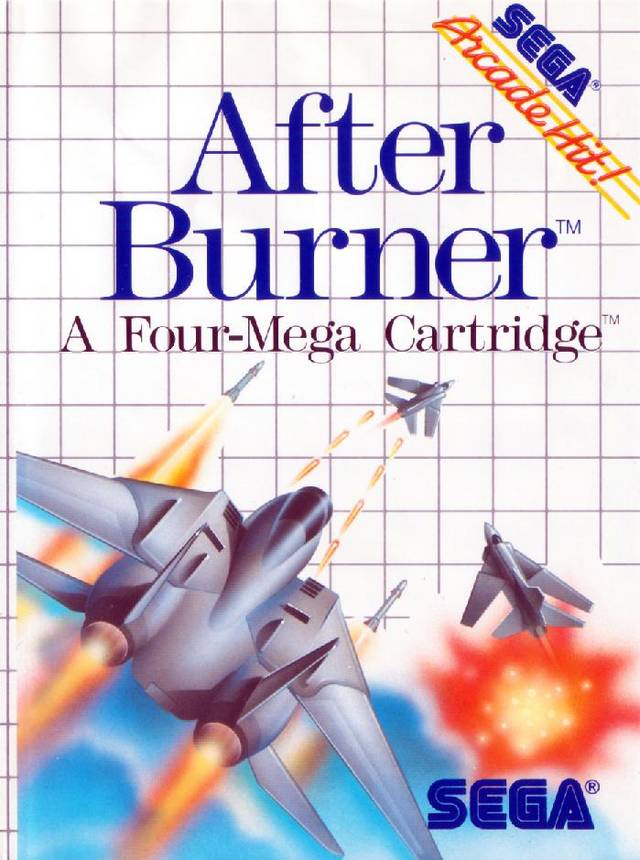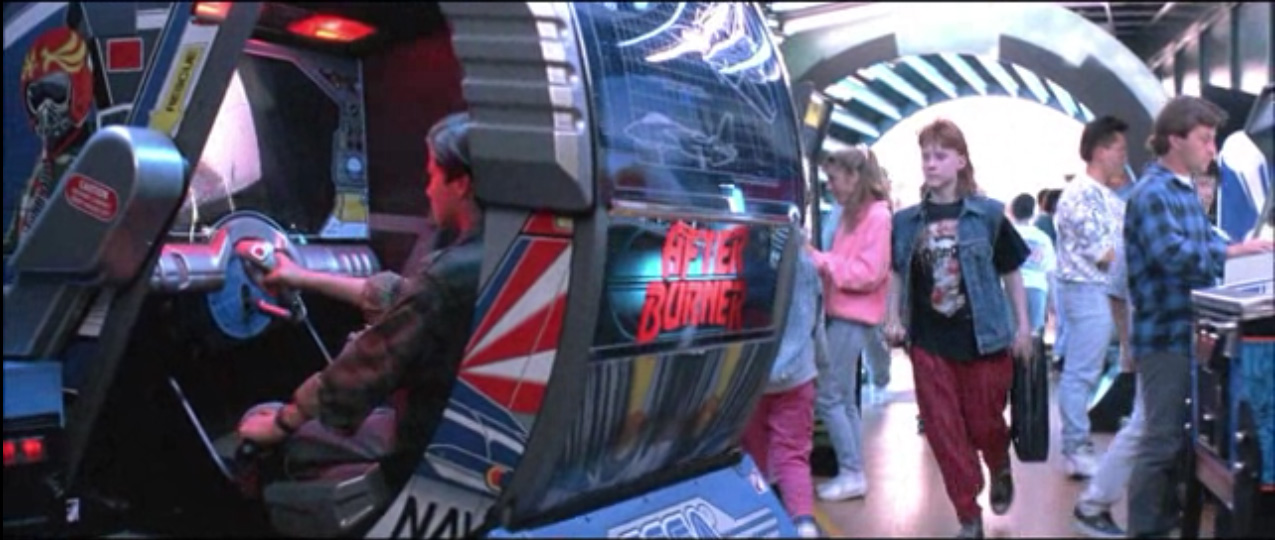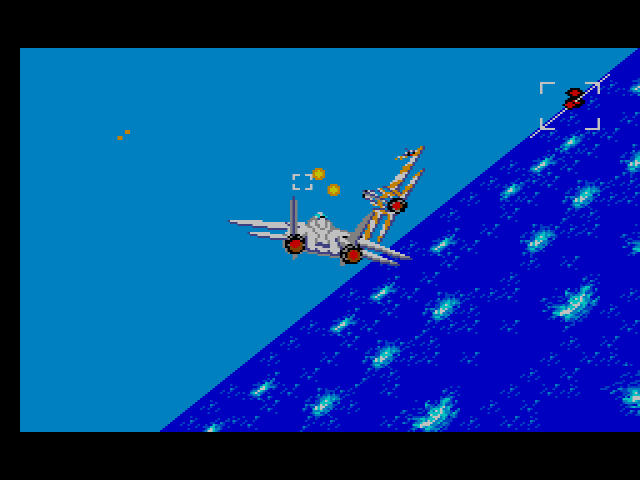

PLAYERS: 1
PUBLISHER/DEVELOPER: Sega
GENRE: Arcade shooter
RELEASE DATE: 12/12/87 – (JP), 03/88 – (US, EU)
Anybody who went to the arcade as a kid in the late 80s/early 90s remembers the After Burner cabinet. Compared to more traditional stand-up cabinets, After Burner was a sit-down cabinet that fully embraced your puny body within its massive confines. The game would often be placed in a corner of the arcade, not because it was unpopular, but because the cabinet took up so much damn space. Because of the cabinet’s placement, as a child, I viewed After Burner as the massive guardian of the arcade. Until somebody approached that was bold enough to challenge it (usually teenagers), it stood watch over the lesser stand-up cabinets, inspiring both reverence and fear in machine and man alike.

If you dared to enter the cabinet’s chamber and insert some quarters, you were met with an immersive experience unlike any other of the time. You controlled an F-14 Tomcat look-alike with the cabinet’s flight stick and shot down other jets. Standard arcade shooter stuff, but it wasn’t After Burner‘s gameplay that reeled you in. It was the movement of the cabinet in time with the jet’s movement. As you controlled the jet with the flight stick, the cabinet would move in tandem with your maneuvering. The seat rotated horizontally, while the cockpit would rotate vertically. The combined movements meant you were in for one helluva of a ride, even if you couldn’t discern much of what was happening on-screen.
![After Burner (UE) [!]001](https://segadoes.com/wp-content/uploads/2015/02/after-burner-ue-001.jpg?w=300)
The fun-factor for After Burner lay in the game’s all-encompassing cabinet. Take that away, and you have a hyperactive, spasmodic shooter that doesn’t so much entertain as it does nauseate. Indeed, your ability to play and enjoy the Master System port will be relative to your ability to withstand the jet’s consistently jerky movements.
As in the arcade, you control the so-called Tomcat through eighteen levels of destruction. While you control the plane’s movements with the D-pad, the game automatically moves the plane forward on a linear path, so you never have to worry if you’re moving in the right direction. Any other jets that come at you are your sworn enemies. Shoot them down with your unlimited machine gun rounds or your limited missile supply. Some jets just fly towards you, while others will shoot homing missiles at you. The homing missiles can be destroyed by shooting at them, but you can’t lock onto them, unlike the jets. Once the game decides you’ve shot down enough jets and avoided enough missiles, it moves you on to the next level and the cycle of explosions begins anew.
![After Burner (UE) [!]002](https://segadoes.com/wp-content/uploads/2015/02/after-burner-ue-002.jpg?w=300)
The Master System does an admirable job of recreating the arcade’s gameplay, which unfortunately includes the game’s faults. One can get used to the barrel rolls and the janky movements if you have a strong stomach, but it can be difficult to discern how far the missiles and the jets truly are from your jet. This forces you to make constant evasive maneuvers. Even when you think you’ve narrowly dodged the projectiles, you’ll often get hit and crash for no explainable reason. The further you get into the game, the more jets and missiles come at you, the more crashes happen, the more you’ll curse After Burner‘s existence.
![After Burner (UE) [!]000](https://segadoes.com/wp-content/uploads/2015/02/after-burner-ue-000.jpg?w=300)
Like Space Harrier, After Burner is a game that was made for the arcade experience. It’s not a bad game, but it’s a limited game brought down by its flaws. The flaws seemed less noticeable in the arcade, because you were too busy enjoying the experience of being throttled. After Burner is as much a ride as it is an arcade game – but this is also its downfall. Since the Master System is incapable of transforming into a human-engulfing stationary roller coaster, “Game over? Who cares, I want to go again!” isn’t something one utters while playing at home.
C


18 replies on “After Burner (Master System, 1987)”
I really dislike the US game boxes. That white with blue grid just looks so lame.
I agree, but I think this After Burner cover is one of the better ones.
I used to own this. There really isn’t much too it except it looked cool at the time. About the only thing notable is the SMS includes a final boss fight against a Flying Fortress bomber that wasn’t in the arcade. Didn’t like it as much as Space Harrier. Flying Mushrooms and fantasy dragons were a lot more interesting that fighter jets.
Yeah, Space Harrier is the more interesting game, no question.
After Burner was quite the movie star. As well as Terminator 2 it was also featured in a deservedly forgotten movie called Suburban Commando starring Hulk Hogan himself. He played an alien who crashed to Earth and thought After Burner was real and that he was really battling enemies and shooting them down. Its for reasons like that the movie is all but forgotten (I only remembered it from an episode of the Nostalgia Critic).
As for the game I never really liked it. I actually leaned more towards G-LOCK because of the variation in camera angles. According to Game Sack, G-LOCK was later re-released on the Mega CD as an After Burner game because that series was better known and they hoped it would improve sales.
Haven’t played G-LOC, but I’m looking forward to it now.
Yeah, I’m not sure what the appeal of After Burner on the console is. Sure, the arcade game was ground-breaking, but the game itself isn’t interesting/good enough outside of that exquisite cabinet.
I think After Burner was just too big of a hit for Sega to ignore, I don’t think I knew of a single arcade from back in the day that didn’t have one, plus it it did show off what the system could do, even if it really didn’t work at home. My understanding is that G-LOC is often considered to be a sequel to After Burner due to the similarities between the games. I know G-Loc was one of the only games to use Sega’s R360 cabinet, which would actually flip you upside down.
Dang, that R360 cabinet must have been expensive. No wonder G-LOC didn’t catch on. Well, that and G-LOC doesn’t have the same ring as After Burner. Reminds me of Tone Loc.
So G-Loc was a lot more fun because it was actually mission based and had more 3D environments to fly in. Added alot of variety. It wasnt that hard to find. Because like After Burner it had a standard upright cabinet and a moving sit down cabinet. The G-Loc sit down cabinet had a lot bigger range of. Option though. It was pretty fun if you could find one. But the best version was the R-360 cabinet. I only played on it once. It took the sit down motion cabinet and extended the motion a full 360 degrees for barrel rolls. It was on.y found at amusement parks and game centers because it required a ride operator. I was lucky to have tried it.
Here is a page showing the After Burner cabinets.
http://www.arcade-museum.com/game_detail.php?game_id=6821
Here are the standard G-Loc cabinets.
http://www.arcade-museum.com/game_detail.php?game_id=7871
And here is the R-360 version.
http://www.arcade-museum.com/game_detail.php?game_id=9217
Sweet, thanks for the links Sean!
I remember seeing that R360 version now, but I believe it was fairly expensive (maybe $2 a game? I can’t remember) so I can’t say if I tried it or not.
I enjoy After Burner on both 32x and Saturn. Perfect for a quick blast due it’s relentless pace and sheer hectic chaos. The Master System and Mega Drive versions don’t quite deliver this frenetic feel but are fair attempts.
But I do agree Space Harrier is the more interesting game.
The game just came out on the 3DS as part of M2 3DS classics series. It is the best version of the game you play. I’d highly reccomend it. It has the exact arcade graphics, but on 3D. And numerous other enhancements, like new gameplay modes, and sound effects mimicking the motors on the moving cabinet, as well as great analog controls.
I’ve heard other good things about Sega’s 3DS offerings. It’s almost tempting me to buy a 3DS just for them. Especially Thunder Blade as that never got a decent home port.
“Your jet leaves a trail of fire as it explodes. Pretty boss.”
That’s not what Duke says when Ace crashes a Skystriker. (In fact, between G.I. Joe and Top Gun, it’s no shocker that Sega picked the F-14 as the jet in this game.)
This is another one of those games that Sega had to port even though the system just couldn’t adequately handle the game.
Oh sure, After Burner is on fire with the comments. It was okay as a home port. I liked it for about 10 minutes at a time, but my room-mate swore it was a vomit-inducer from the first time he saw it. And I think I left it alone and stuck with Golvelius while he was home just because of that. Still, from the moment the Tomcat takes off from the flight deck of the carrier and I heard the rawk music, I had high hopes it would be an awesome arcade port. Thank God for the 3ds port.
Oh, and the arcade had some of the loudest speakers blasting like a sonic vise on both sides of your poor cranium. Man, how could you bring that home on the Master System?
My thoughts exactly. Why even try?
I remember playing this as a kid. I could get through quite a bit of the game by sticking to one of the top corners.